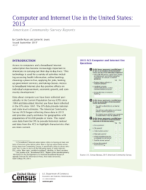Computer and Internet Use in the United States: 2015
Computer and Internet Use in the United States: 2015
Introduction
Access to computers and a broadband Internet subscription has become increasingly important to Americans in carrying out their day-to-day lives.1 This technology is used for a variety of activities including accessing health information, online banking, choosing a place to live, applying for jobs, looking up government services, and taking classes. Access to broadband Internet also has positive effects on individual empowerment, economic growth, and community development.2
Data about computer use have been collected periodically in the Current Population Survey (CPS) since 1984 and data about Internet use have been collected in the CPS since 1997. The CPS data provide national- and state-level estimates. The American Community Survey (ACS) began collecting these data in 2013 and provides yearly estimates for geographies with populations of 65,000 people or more. This report uses data from the CPS to provide historical context and data from the ACS to highlight characteristics that are more current.
Highlights From ACS Data
- Among all households, 78 percent had a desktop or laptop, 75 percent had a handheld computer such as a smartphone or other handheld wireless computer, and 77 percent had a broadband Internet subscription.
- Households headed by a person aged 65 and older lagged behind households with younger householders in computer ownership or use and the likelihood of having an Internet subscription.
- Households with an Asian householder were most likely to own or use a desktop or laptop, own or use a handheld device, and have a broadband Internet subscription.
- Households in metropolitan areas were more likely to report owning or using a desktop or laptop or a handheld device and subscribing to broadband Internet compared to their nonmetropolitan counterparts.
- States on the Pacific Coast and most states in the Northeast had higher levels of broadband Internet compared to the national average.
- Overall, 62 percent of American households had “high connectivity,” meaning they had three key computer and Internet items: a desktop or laptop, a handheld computer or smartphone, and a broadband Internet subscription. High connectivity was highest among households where the householder was less than 65 years old or had a household income of $150,000 or more.
__________
1 A “broadband” Internet subscription refers to having at least one type of Internet subscription other than a dial-up subscription alone. In the American Community Survey, it specifically refers to those who said “Yes” to one or more of the following types of subscriptions: DSL, cable, fiber optic, mobile broadband, satellite, or fixed wireless.
2 See Jayakar et al., “Broadband 2021,” Report of the Interdisciplinary Workshop on the Development of a National Broadband Research Agenda, Institute for Information Policy, Penn State University, State College, PA, 2016.
Others in Series
Publication
Publication
Publication




